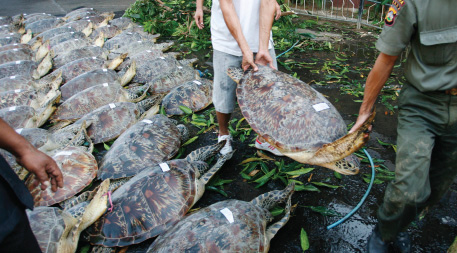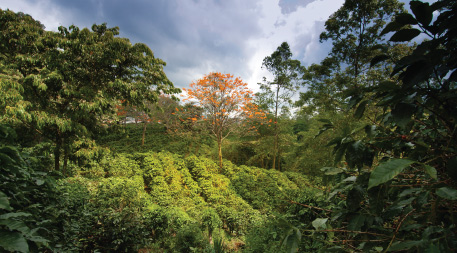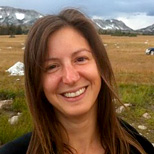July 22, 2013 — Conservationists are used to justifying their work. Since the movement first took shape in the 1800s, they’ve provided a litany of contemporary arguments for conserving the natural world, from economic (protecting forests for wood) to spiritual (preserving places that stir the soul) to scientific (safeguarding biological systems). But lately they’ve been wrestling internally with another fundamental question about their task: not why we should save nature, but what exactly we should save and how we should save it. Against a backdrop of growing global resource demand and climate change — as well as emerging technologies, such as synthetic biology — that are wreaking philosophical havoc, finding the answers is urgent.
At issue is how to modernize a predominantly 20th-century enterprise. Since at least the 1960s, biodiversity conservation has largely taken its cue from the health of particular species. It’s been reactive, focused on stopping things: habitat loss, habitat fragmentation, extinction. But despite valiant efforts, billions of dollars and years of long-fought battles, conservation seems perpetually on the losing side of a war.
For evidence, look no further than the International Union for the Conservation of Nature’s Red List Index, which shows trends in the conservation status of mammals, birds, amphibians and corals. According to the IUCN’s website, the index “clearly demonstrates that the status of these major groups is still declining.” Around the world, we’re transforming ecosystems at an ever-increasing rate. Even in areas set aside for wildlife — at great expense and effort — animals are struggling to survive amid frustratingly hard-to-squelch activities such as poaching and logging. It’s not that there haven’t been individual success stories — particularly in the U.S., where 40 percent of threatened or endangered species are stable or improving. Even those successes, however, come with caveats: 84 percent of species listed under the Endangered Species Act may require sustained human intervention in order to survive, according to a paper published by University of Idaho biologist J. Michael Scott and colleagues in 2010.

In the past, conservation initiatives often focused on individual species – usually cute, cuddly or otherwise charismatic ones. Today’s conservation calls for a more comprehensive approach. Photo by Don Wallen, University of Washington Libraries, Special Collections, MPH893.
“We know absolutely that something has to be different,” says Jon Hoekstra, chief scientist at the World Wildlife Fund. “In the 21st century, instead of starting with only 2 or 3 billion people, we start with 6 and go to 9, and do it under changing climate conditions and intense resource demands. The context of conservation is going to be profoundly different.”
“Overall,” says Kent Redford, a conservation biologist who spent many years at the Wildlife Conservation Society and now runs his own consulting firm, the current tools of conservation “are not up to the problems as they either are or will soon be.”
Battle Lines & Shared Ground
Chat with a conservation leader today and you’re likely to hear some fairly surprising things. We can’t do it species by species. Protected areas aren’t going to be enough. Saving the last place or the last of the species is not our focus.
The exact messages may differ — after all, there may be as many distinct conservation agendas as there are places, creatures and ways of life — but the theme is constant: Something needs to change. Conservation today is in need of a far more potent approach.
Answering those looming questions — what to save, how to save it — has sparked heated debate among practitioners. Last year the Breakthrough Institute, the pragmatic think tank that’s been a thorn in the side of traditional environmentalism since its inception in 2003, published an essay by Peter Kareiva, chief scientist of The Nature Conservancy; Robert Lalasz, TNC’s director of science communications; and Michelle Marvier, an ecologist at Santa Clara University. Titled “Conservation in the Anthropocene,” the essay argued that conservation is failing in its efforts to save both biodiversity and ecosystems, despite setting aside an impressive number of protected areas. To succeed, the authors wrote,
conservation could promise instead … a new vision of a planet in which nature — forests, wetlands, diverse species, and other ancient ecosystems — exists amid a wide variety of modern, human landscapes. For this to happen, conservationists will have to jettison their idealized notions of nature, parks, and wilderness — ideas that have never been supported by good conservation science — and forge a more optimistic, human-friendly vision.
The piece exposed a huge rift in the conservation world and ignited a feud that raged on the institute’s website and spilled over onto Andrew Revkin’s Dot Earth blog. John Lemons, an emeritus professor at the University of New England, took the authors to task for substituting value judgments for science and failing to recognize the “intrinsic values of organisms, species or ecosystems.” Kierán Suckling, executive director of the Center for Biological Diversity, accused the authors of “exaggerations, straw-man arguments and a forced optimism that too often crosses the line into denial.”
Intense disagreement persists over how best to protect the planet’s ecosystems and biodiversity. But there may be more shared ground than anyone realizes — and it’s there we should look for the future of conservation, and of the natural world.
Yet even Suckling acknowledged that in the current moment, “conservationists need honest, hard-headed reassessment of what works and what needs changing.” On that point, it seems, few people disagree.
Even as some in the conservation community have drawn battle lines (in a now-infamous exchange at the Aspen Institute last summer, E.O. Wilson asked Emma Marris, author of the future-of-conservation book Rambunctious Garden, where she planned to plant the white flag she was carrying), much of the rhetoric has begun to hit on surprisingly common themes. Intense disagreement persists over how best to protect the planet’s ecosystems and biodiversity. But there may be more shared ground than anyone realizes — and it’s there we should look for the future of conservation, and of the natural world.
180-Degree Turn
WWF’s Hoekstra likes to talk about “the pivot.”
Reactive and defensive almost by definition, conservation has long made its living by explicitly looking backward. It’s an approach that made perfect sense, for a time. “We wanted to restore a species so that it spanned the breadth of its historic range,” says Hoekstra. “We would look to the past and say, ‘We should have this much of this habitat back again, or it should look this way.’” But while this strategy may still work in certain specific cases, as an overarching vision it no longer fits. You can’t “dial back time” in a world of 9 billion people demanding water, food and energy.
In other words, we can’t stop progress, but we can shape it.
Hoekstra’s pivot is a 180-degree turn, shifting conservation to face the future. Population trends and global warming will leave the world looking very different than it does now, and no amount of money or effort seems destined to stop that. But we can, Hoekstra believes, try to ensure that a changed planet isn’t a less healthy one. The way forward is to look forward: “Anticipating some of the trends that will be driving that change,” Hoekstra says, “how can we influence it so as much nature comes with it as possible?” In other words, we can’t stop progress, but we can shape it.
With the pivot, the goals of conservation remain roughly the same — protecting natural habitat, preventing species from vanishing — but they’re set within an entirely different frame. Instead of asking, “How can we stop this thing we don’t want?” — exurban sprawl in place of a prairie, say — we might ask, “How can we engineer this thing we do want?” — thriving urban centers or wildlife-friendly ranchland, for example. Instead of setting aside vast tracts of land, we stitch together mosaics — landscapes that combine sustainable food production with natural habitat. “If we apply conservation science in a smart way,” Hoekstra says, “we can make those landscapes work for people and protect biodiversity. We’re not going to always get both those things right, but I think it’s our only chance.”
So, the pivot is about managing change rather than trying to stop it. Which sounds similar to what Ted Nordhaus, chairman of the Breakthrough Institute, has been saying lately. “The question isn’t whether Brazil is going to develop the Amazon,” argues Nordhaus. “It’s how. You have to think about how you’re going to work with that process as opposed to resist it.” If you think you’re going to somehow block every dam that’s proposed, Nordhaus says, “you can’t have a conversation with the Brazilian government about how Brazil can utilize the resources it has in a way that preserves as much of the landscapes and species we want to preserve as possible.”

Intercepting poachers and taking possession of their plunder is a common – but not always effective – way to combat illegal wildlife trade. In a more innovative approach, conservation groups are working to reduce consumer demand for products from protected species. Photo by Zuma Press, Inc./Alamy.
That sentiment rankles many conservationists who believe it amounts to letting greedy, destructive forces have their way. Far from signaling surrender, though, the heart of this idea is about proactively orchestrating peace. It’s about setting the agenda rather than reacting to it. The current approach, says Peter Knights, executive director of the conservation group WildAid, resembles the drug war, with law enforcement defensively responding to criminals’ latest gambits. “You can’t enforce your way out if there’s a strong demand on the other side,” says Knights, whose group works to stop the illegal wildlife trade by halting demand for products like ivory and shark fin rather than futilely attempting to curtail supply. By changing consumer preferences instead of trying to outmaneuver highly motivated poachers, WildAid is a model of the shift to a less-reactive version of conservation.
Triage Gone Right
Managing change means making painful decisions — even, sometimes, acknowledging that we can’t save everything. How do we decide what to save and what to let slip away? And who has the right to decide?
These questions have always been contentious and uncomfortable. Even among scientists, there are value decisions at work. Back in 2002, Brian Bowen, a conservation geneticist at the University of Hawai’i at Manoa, published a paper laying out what he called “a tripolar debate” among subsets of biologists over whether conservation should strive to preserve genetic uniqueness, ecosystems or the potential for organisms to adapt and evolve. The answer, concluded Bowen, involved a synthesis of the three. “In order to be successful,” he wrote, “conservation efforts must preserve the processes of life.”
The power of preserving processes — biological, ecological, evolutionary — is another platform where conservationists can find common ground. Our best buffer against the impacts of global warming and development “is to safeguard the stage that will allow nature to evolve in the best way possible,” says Jamie Williams, president of The Wilderness Society. Williams is convinced the future lies in creating “large, resilient ecosystems” that combine public and private lands, protected and working landscapes.
“We need to look at where we can truly be successful on a meaningful scale, which means we might have to let some of the smaller things go.” — Jamie Williams
“We need to pay attention to species,” Williams says, “but we’re in a different world now. We need to look at where we can truly be successful on a meaningful scale, which means we might have to let some of the smaller things go.”
Not long ago, it would have been heretical to hear a conservationist talk about letting some species vanish. But in the new, proactive world, consciously making such decisions is a whole lot better than letting them happen by default. How we choose remains an open question, yet it’s increasingly apparent that we do in fact need to make choices.
In an article in Scientific American last year, journalist Michelle Nijhuis wrote about “conservation triage,” chronicling a 2008 meeting of Wildlife Conservation Society researchers who’d gathered — with a psychologist on hand — to decide which species they should try to save. “We actually do a huge amount of triage now, but we do it really poorly, without planning in advance,” says Tim Male, vice president of conservation policy at Defenders of Wildlife. “It’s not about needs, it’s about noise.” Whichever patient in the hospital is screaming the loudest, Male says, gets the attention. “It’s triage gone wrong.”
While the conservation ideal may always be to save as many places, organisms and processes as possible, managing change means recognizing that trade-offs may be necessary — and engineering them in the smartest, most sophisticated way possible.
Male helped organize a conservation triage workshop at this summer’s International Congress for Conservation Biology, which he hopes will pave the way for a system of prioritization “beyond the fire drill of the day.” The greatest value of explicit prioritization, he says, is letting people know exactly what they can achieve for a certain price. It answers the question, “If we add another million dollars, what’s the outcome?”
While the conservation ideal may always be to save as many places, organisms and processes as possible, managing change means recognizing that trade-offs may be necessary — and engineering them in the smartest, most sophisticated way possible. “All in all, conservation is moving beyond the issue of individual species or individual places to larger landscapes,” says Cristián Samper, president and CEO of the Wildlife Conservation Society. “This will be absolutely crucial as we go forward.”
Synthetic Survival
This past spring, in Cambridge, England, two groups of scientists eyed each other suspiciously as they poured their morning coffee. The occasion was a gathering of conservation biologists and synthetic biologists, strange bedfellows convened by conservation biologist Kent Redford and colleagues. Synthetic biology — the creation of new life forms — is still in its infancy. But along with the increasingly real likelihoods of bringing mammoths, passenger pigeons and the like back from oblivion, or of engineering organisms to be a better fit for the altered world they’re inheriting, the field is spurring conservationists to an insistent form of soul-searching.
Introducing man-made organisms into natural systems is a notion that fills many ecologists and conservation biologists with horror, imagining the havoc these novel life forms might wreak. But here, too, there is opportunity to help set the course. Synthetic biology might unfold without any thought for the needs of natural ecosystems. Or its vast potential might be harnessed in the service of sustainability.
“Though these communities are strangers to each other now,” wrote Redford and two co-authors in a paper published just before the meeting, “the work they do and the goals they pursue are in places complementary and in others conflicting but uninformed by each other.”
No blueprint for a perfect planet emerged from the Cambridge confab, but Redford believes some seeds were planted. After a lot of “us” versus “them” posturing, by the end of the meeting both sides were excited about opportunities to collaborate. “They’re tool-driven people by and large,” Redford says of the synthetic biologists. “They develop new ways of doing stuff and then look for things to be done with them. We got to say, ‘Well, could you help us do this? Or what about that?’”
All Hands on Deck
Whatever the approach, it’s clear that enlisting new constituents is essential.
More and more, conservationists are partnering with farmers, looking for ways to trade ideas and manage food-producing lands as part of large, resilient ecosystems. “We no longer can afford to be about, we’ll conserve this over here, you go do your stuff over there,” says Hoekstra. “How could conservation and agriculture work together? What can they learn from each other? There are really sophisticated agricultural practices and technologies, so what might we adapt and apply to promote conservation and what from conservation could be applied to the world’s farmland?”

One strategy for conservation in an increasingly crowded world is to design land use to meet multiple needs. Tree-studded coffee fields in Costa Rica, for instance, blend nature and agriculture for the benefit of both. ©iStockphoto.com/2tamsalu
Including sustainable development as a core conservation goal, and looking for all possible tools to achieve it, is another emerging area of common ground where future solutions certainly lie. One WWF project in Mozambique, for instance, marries conservation and human development through a partnership with the people-focused group CARE to promote local management of fisheries.
But 21st-century conservation also involves getting far-reaching buy-in, spreading the conservation ethic to emerging economies. “You really need support from everyone all over the world,” says WildAid’s Knights. “China is going to increasingly become a source of funding for international conservation projects. As a movement, we’re still very focused on Washington and the U.S., but trade and power dynamics are shifting.”
Convincing developing nations to consider sustainability as they grow looms large in Nordhaus’s agenda, too. If you can’t stop Mongolia from mining, the only solution is to help Mongolians balance their desire to mine with our desire to preserve ecologically vital steppe and other natural landscapes.
Enlisting new participants is also about considering psychology. Conservation biologists, like scientists in many fields, have long labored under the delusion that if they can just get people to understand the science, smart decision making will naturally follow. But science is often no match for the power of belief systems and self-reinforcing social groups. It’s essential, says Redford, for conservation to begin integrating lessons from behavioral psychology, to better understand how people change their mindset — rather than continuing to “say the same thing even louder.”
It’s just one more attempt to engineer change rather than build barricades. As the world shrinks, effective conservation policy will need to set the course instead of simply steering the ship around obstacles. Fortunately, choosing that course may be less contentious than it seems, particularly since there’s broad consensus that we need new maps. It’s as good a starting point as any for the long voyage ahead. ![]()
Ensia shares solutions-focused stories free of charge through our online magazine and partner media. That means audiences around the world have ready access to stories that can — and do — help them shape a better future. If you value our work, please show your support today.
Yes, I'll support Ensia!

The Breakthrough Institute is mentioned in the article. The group states it is pragmatic and understands partisan politics have failed us. But do they recognize Obama's 'clean' energy stimulus has failed? To state you are both pragmatic and progressive seems to be a major contradiction. And to believe a government is better than private sector is simply intellectually dishonest.
Although, I do agree conservation is very add-hock and some kind of holistic approach needs to be created as many conservationists are all fighting for different things but are also fighting for similar causes. So instead of having ‘the pivot’ approach resulting in trade-offs perhaps effort should be placed into some kind of umbrella organisation that works to combine forces of NGO’s, organisations, charities etc. This could help move funds around and be placed into areas of need. This will be extremely difficult but so will choosing the species to save. Surely conservation should not be placed in a position where it lets a species die.
I have always thought tourism has a very distinct role to play in this kind of argument. It may be an old sustainable tourism argument, but it’s a good one. Instead of fighting the poachers who are working to make money, why not give them an alternative means of making cash, tourism! This will help the local population see the value of conservation and create an income from people who come to experience the natural environment in which they live. The article discusses an approach to change consumers preferences to reduce the demand for the poaches work. This is a ridiculous and an impossible task. Why not look towards the poachers, who are of a smaller number when compared to the consumers, and give them an alternative to poaching?
follow me on twitter @saul1985